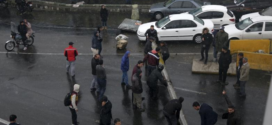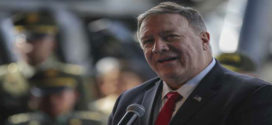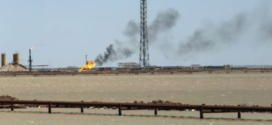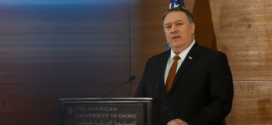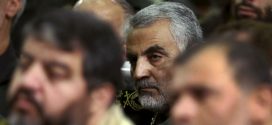
By: Ray Takyeh 19 March 2020
The era of arms-control diplomacy in U.S.–Iran relations has ended. The Trump administration will not be able to negotiate a new nuclear agreement with Iran. And should the Democrats reclaim the White House, they will not be able to revive the old one. None of this has much to do with the fact that Trump withdrew from the Iran nuclear deal, the Joint Comprehensive Plan of Action (JCPOA). Rather, it is the result of the ascendance of Islamist hardliners and scientists who are more interested in the bomb than in another accord with America.
Two key factors made the JCPOA possible. The first was an Iranian president who believed that the key to his country’s economic fortunes was an arms-control agreement that would pave the way for foreign investments. The second factor, which is rarely discussed, was the willingness of the Iranian scientific community — specifically the folks in the Atomic Energy Organization, the country’s nuclear-regulatory body — to accept restrictions on the program. Neither factor is present today or likely to recur.
Upon assuming the presidency in 2013, Hassan Rouhani sought to resuscitate an economy that had essentially collapsed. The sanctions imposed on Iran by the United States and Europe because of its nuclear infractions had drained its treasury. Rouhani was too careful a politician to embark on structural economic reforms whose political ramifications he feared. His formula for dealing with all this was to attract foreign investments and restore Iran’s place in the global economy. None of this would be possible without an arms-control agreement that would demolish the wall of sanctions.
In 2015 a triumphant Rouhani obtained an agreement that he assumed would trigger the return of international commerce. At the instruction of President Barack Obama, Secretary of State John Kerry traveled throughout Europe pleading with corporate boards to place their bets on Rouhani. Kerry advised European banks and companies that had left Iran because of sanctions to return now that the agreement had removed the barriers to trade. But Iran was too risky a country, and its imperial rampage across the Middle East too troubling to bankers and investors. Iran did manage to sell more oil, but the economic boom never came. Inflation continued to ravage the average Iranian household while unemployment deprived yet another generation of a meaningful future. In 2020, as Rouhani’s presidency limps toward its end, the notion of relying on foreigners bearing gifts has no constituency in Tehran.
In the midst of this trouble, Rouhani’s government has been jolted by the coronavirus. The mishandling of the outbreak of the virus is yet another indication of the combination of incompetence and mendacity that has characterized the Islamic Republic’s tenure. The regime at first denied the scope of the problem, even though scores of its own officials were stricken by the illness, and has yet to put together a system for containing its spread. Iran was one of the first nations to be afflicted by the virus and will be one of the last to recover.
As for Rouhani’s economic postulations, these never sat well with Supreme Leader Ali Khamenei and the hardliners. In their eyes, a revolution against international norms should not be beholden to Westerners. Khamenei has long championed an outlandish theory called the “economy of resistance,” according to which Iran can meet its needs by relying on its own people. This brand of autarky mandates weaning the country off its oil exports. Khamenei recently said, “I strongly believe that the key remedy to the country’s problems stands in promoting internal production” and that “the major factor causing our economic problems is dependence on oil.” The notion that a nation of 80 million people can dispense with its principal export commodity and sustain itself by relying solely on its internal markets borders on lunacy. But for Khamenei, the issue is not financial balance sheets but rather shielding the revolution from external influences. The lesson that he learned from a decade of confrontation with the West over Iran’s nuclear program is that, so long as Iran depends on oil and natural gas, it will be vulnerable to outsiders who control the market. If the price of the revolution is national poverty, he is willing to pay it.
The themes of isolation and autarky have been picked up by Khamenei’s hardline disciples. Mohammad Reza Naqdi, a senior commander of the Revolutionary Guards, insisted that “our primary problem is that too many people believe that our economic difficulties will be solved if we establish ties with America.” A former mayor of Tehran, Mohammad Baqer Qalibaf, who was recently elected to the parliament and hopes to become its next speaker, chimed in to claim that only 30 percent of the country’s problems are due to sanctions while the remaining 70 percent are the result of poor management. But the conservatives are hardly reliable custodians of the economy, as indicated by the disastrous presidency of Mahmoud Ahmadinejad, which left the country nearly bankrupt.
Still, under the watchful eye of Khamenei, the hardliners are beginning to wrest control of the elected institutions from Iran’s enfeebled moderates. The hardliners were always in charge of the most consequential state organs, such as the security services and the judiciary, but now they are extending their tentacles throughout the system. In the most recent parliamentary elections, the Guardian Council, which is responsible for vetting candidates for public office, disqualified most reformers, thus ensuring a conservative majority. A similar pattern is likely to repeat itself in the next presidential election, to be held in 2021. The new crop of reactionaries adhere to Khamenei’s eccentric theories of economic planning. They are not likely to accept any restraints on Iran’s nuclear program in exchange for Western commerce. The era of dangling Western carrots to induce the Iranians to give up their nuclear assets is over.
The conventional wisdom has long insisted that Iran agreed to the nuclear accord because of the pressure of sanctions. There is no doubt that the financial stress caused Rouhani to look for escape hatches. But what tilted the Islamic Republic toward the agreement was a subtle debate taking place within the Atomic Energy Organization, as exemplified by the stances of Ali Akbar Salehi and Fereydoon Abbasi, who led the agency at different times and had contrasting ideas about how to attain the capacity to make nuclear weapons. By understanding this debate, we can appreciate why Iran opted for an agreement in 2015 and why it will not do so today.
In interviews, Abbasi portrays himself as an authentic revolutionary who earned a doctorate in nuclear physics in an Iranian university rather than going abroad. His prominence was ensured in 2010 when, while a university professor, he was the target of an assassination attempt, most likely by Israel. Less than three months later, he was put in charge of the Atomic Energy Organization. Abbasi believed that Iran must continuously expand its nuclear capacity, even if that meant relying on primitive technologies. He kept adding vintage IR-1 centrifuges to Iran’s growing stock of machines and talked about enriching uranium at ever-higher levels. In the firebrand Ahmadinejad, Abbasi found the ideal patron, a president whose truculence required an expanding nuclear program. But Iran paid a heavy economic price for those incremental gains, and as the United Nations condemnations piled on, no one could guarantee that Iran’s nuclear sites were safe from attack by America or Israel.
All this did not sit well with Salehi and many within the Iranian scientific community who believed that Iran needed to modernize its infrastructure and above all develop a new generation of advanced centrifuges that could operate with efficiency. The modernizers were indeed the cannier bomb-makers, for they realized that once Iran had a reliable inventory of advanced centrifuges it could then quickly manufacture material needed for nuclear bombs. They further knew that a limited cascade of such machines could be installed in small facilities that could easily evade detection, but that such a clandestine nuclear apparatus would require state-of-the-art technology. All Abbasi was doing was building clunky machines prone to break down. And he needed thousands of such devices, which meant that his installations were too large to escape detection.
In 2013, Rouhani’s presidency tilted the balance of power within the Atomic Energy Organization toward the modernizers. Abbasi was dispatched back to the university, and Salehi assumed control of the agency. Regarding a possible nuclear agreement with the U.S., Salehi’s most important demand was a vibrant research-and-development program to renovate the nuclear infrastructure. One of his aides, Pezhman Rahimian, conceded, “The current manager of the organization believes that we should not have installed this number of IR-1s, since plans were made to replace these old centrifuges with new ones.” So Salehi was prepared to junk a considerable number of the antique machines that his predecessor had assembled. In 2015, Iran needed approximately eight years to complete the work on the new generation of centrifuges. The JCPOA stipulated that Iran could install such machines at precisely that time. John Kerry got his talking point: In 2017 he could go around claiming, “When we sat down to begin that negotiation, there were more than 19,000 centrifuges spinning. . . . The number of centrifuges today is down to about 5,000.” What he neglected to mention was that those machines were to be phased out anyway.
In summer 2015, as Iran debated the nuclear accord, the modernizers laid their cards on the table. Salehi led the charge, insisting, “According to the JCPOA, we have kept our nuclear program in accordance with our needs and requirements for research and development.” Rouhani similarly stressed, “Through this agreement, we have paved the way for the country’s speedy development in the research field and for the progress of peaceful nuclear science.” Iran’s once-illicit nuclear program was now legitimate, its attempt to upgrade its technologies accepted by the United States and the international community.
In the intervening years, Iran has steadily raised its technical capacity. In 2017, Salehi boasted, “If we want to, we can enrich to 90 percent” (weapons-grade). As part of its reaction to America’s withdrawal from the JCPOA, Iran has routinely renounced aspects of the agreement. In January it went one step further and declared that it would discard all its obligations. The assembly lines were already humming along, with newer models of centrifuges in production. The most recent report by the International Atomic Energy Agency reveals that Iran has now accumulated sufficient enriched uranium for at least one bomb. And the agency is being denied access to two sites of suspicious activity. Iran’s nuclear program is approaching a takeoff point; it needs just a few more years to become state-of-the-art.
The success of the modernizers means that a critical constituency that supported the previous diplomatic efforts to resolve the nuclear issue is no longer inclined toward compromise. The modernizers are in charge, and they will not concede on capabilities that they have struggled to bring on line over the past few years. The Trump administration is sensibly insisting on an agreement that shuts down Iran’s enrichment plants, something that Salehi and his cadre will not accept. Joe Biden, like the other Democratic presidential candidates, has talked of returning to an agreement that is already disappearing as its many sunset clauses age. If the Democratic nominee wins in November and wishes to negotiate an extension of those restrictions, that effort will be met with a wall of resistance from Iran’s Atomic Energy Organization.
Although Rouhani and his cagey foreign minister, Javad Zarif, have garnered the most attention for negotiating the JCPOA, the critical actor in convincing Khamenei to sign off on the accord was Salehi. The MIT-trained physicist has always been Khamenei’s most ingenious bomb-maker. And it is unlikely that Khamenei, whose imperial ambitions in the Middle East require the ultimate weapon of intimidation, will reject the advice of his trusted scientists for the sake of another agreement with the United States and its allies.
3
In today’s Iran, neither the political class nor the scientific establishment wants a new nuclear agreement. Khamenei and the hardliners don’t believe that the sanctions are the primary cause of their financial predicament and insist that they can revive the economy by isolating it from global markets. They are wrong, and it makes them impossible interlocutors for enterprising Americans. In the meantime, Salehi is on the verge of modernizing a nuclear infrastructure that can produce bombs quickly and, he hopes, without getting detected. All this means he will not yield to any proposed restrictions.
It is time we abandon the delusion of arms control and focus on undermining a regime that has lost its popular mandate. The Islamic Republic is bound to follow other discredited ideological experiments of the 20th century into the dustbin of history. Instead of chasing another agreement, we must adopt Ronald Reagan’s famous dictum: We win, they lose.
 khalijefars News, Blogs, Art and Community
khalijefars News, Blogs, Art and Community
